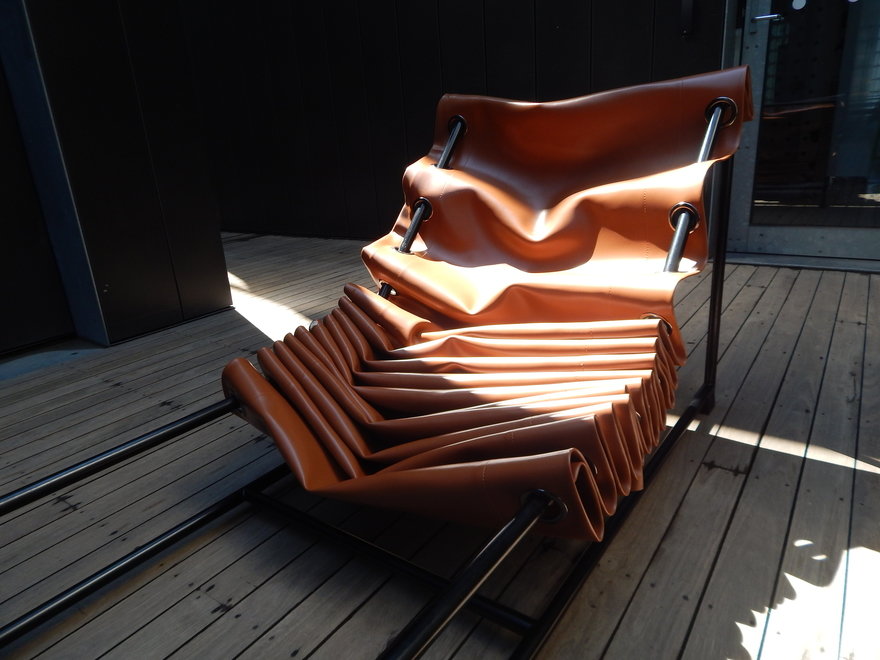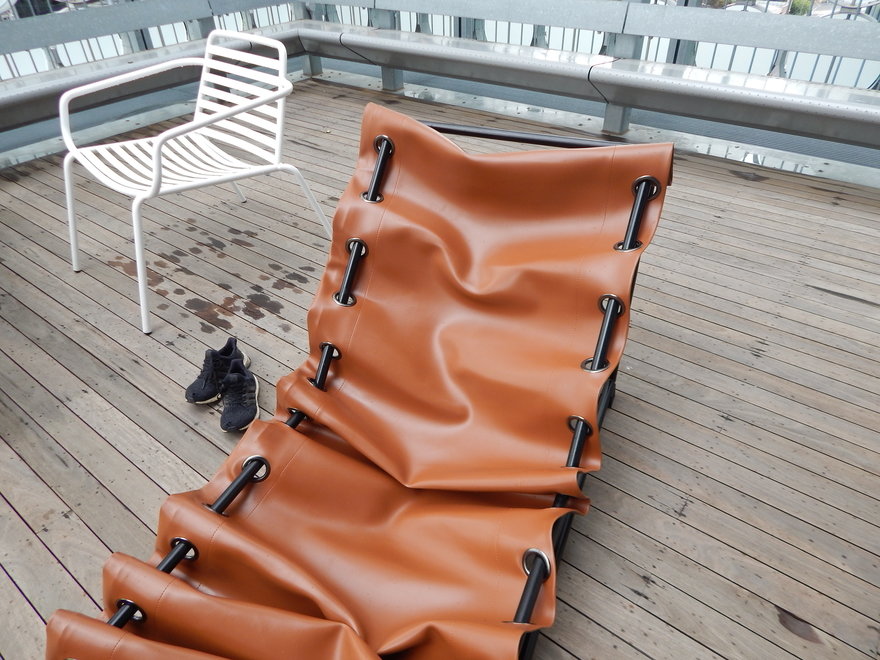
- Student
Be Right Back: Haptic Furniture
Inspired by the concept of curtains, Be Right Back was designed in consideration of individual needs found in relaxation and stress relief. The push-pull motion enables its user to "fidget" - an action done out of boredom or stress to stimulate the brain.
The innate desire to complete tasks and progress through stressful environments are indicative of our adaptation and development of our individual methods to cope and manage stress. It is clear that there is no single, correct approach to achieving relaxation as every person possesses their own way of managing stress, reflective of their character and individuality.
The Be Right Back project has explored various social behaviours and cognitive elements of the relaxation process. Its aim was to design an object that amplifies the individual's relaxation capabilities, identifying various relaxation methodologies and be able to incorporate this notion of dichotomy in passive and active relaxation.
To achieve this, I investigated an array of habits and behaviours of individuals in achieving the optimal level for relaxation, as well as chair structures that would help facilitate and cultivate relaxation for its users. However, it is imperative that we recognise the aim of the relaxation process – that is, to evoke emotions and sensations.
Designing for such would require an understanding of theories beyond ergonomics in furniture, and instead place emphasis on the ways we can induce relaxation through physical means.
Design Team
Honours Supervisor: Ronnie Lacham
Emotions play a major role in determining our daily stressors. Essentially, if we lose touch of our emotions, we lose touch to what was once valuable, and the ability to cope, resulting in stress. Emotions give us a sense of congruity or wholeness, a sense of being a whole self, which is important as human beings to not feel fragmented. Engaging in our senses offer a quick and effective way of relieving stress and feeling more relaxed. When an individual is stressed, it is easy to get disconnected from the body's best coping mechanisms – the senses.
Naturally, as human beings, we match our current daily life to the past every single day, as seen in the way individuals develop daily routines. In order to experience our surroundings, we make connections between memories and the information we are exposed to.
Aspects of Design
Form
Form, as a visual characteristic of the environment, can influence our emotional reactions to interior environments. Evoking emotions through design can provide rich interactions and influence satisfaction with objects we use in our daily lives. They can appeal to people through their visual appearance such as their colour, form, size and texture, and through their usability, context and affordability. Although emotions are not possible to measure comprehensively, some aspects of them can be measured. Experts say that as human beings, we can be influenced to a degree that certain types of furniture might be more appealing.
Motion
In relevance to the idea that we, as individuals, are more comfortable in some form of activity, movement becomes its own dimension within the realm of furniture design. Motion plays an essential factor in achieving the ultimate level of comfort in the design of furniture. For example, the swinging or rocking motion, as discussed by Dr. Harvey Karp (2016), is reminiscent of a new born and their ability relax and fall asleep when rocked in a cradle. Movement has a direct effect on our mood and encourages relaxation. Such notions can further be found in modern day rocking chairs, a tool often used to help relax in the comfort of our own homes. A connection can also be established in our ability to fall asleep on transport, both in cars and on trains – the human body is relaxed when we are in a slight and steady motion.
Curvilinearity
According to Papanek (1995), roundness contributes to the perceived youthful age of a product due to association with a child's facial features or expressions. As a result of this physiognomy, curvilinear forms can evoke feelings of joy, warmth and pleasure compared to rectilinear forms (Dazkir, S. S., & Read, M. A.,
2012). Rectilinear forms are seen as 'stressful', 'annoying' and 'angry', making it less ideal for it to be placed in an indoor space. Additionally, curved furniture can be more comfortable when it follows the natural contours of the human body, placing emphasis on the beauty and harmony to the body, mind and spirit. Hence wise, suggesting that designing furniture or objects with curvilinear forms would therefore promote feelings of happiness, calmness and relaxation.
Movability and Spatial Compatibility
Movability is an important characteristic to consider in furniture. The power of freedom and flexibility in interior design remains within the spectrum of choice of its user. Absence or lack of movability in an object's design may create barriers to the individual's spatial freedom – resulting in possible obstruction of path and restrictions on how to position a piece within a designated space. Limitations in the positioning of a piece of furniture or how it may be manoeuvred within the designated space will also impact how other objects may fit in the final picture. In creating furniture that facilitates movability, each element of the room may be deconstructed, reconstructed and manipulated to accommodate subjective tastes and each user's vision.
Our subconscious mind has the ability to greatly impact our natural behaviours and our ability to perform tasks. It refers to the mental framework that we, without thinking, apply to everyday situations and scenarios, and enables us to act or behave in certain ways. Whilst the conscious mind is the element that actively makes decisions, the subconscious can be described as the inactive aspect of our mental state, playing the role of a programmer that creates natural, automated reactions/response to various stimuli. The subconscious mind is the reason we feel discomfort, both physically and mentally, when we are exposed to unfamiliar experiences or tasks. For example, individuals with acrophobia will feel fear when held at high points – this feeling is triggered by the subconscious of the said individual. Additionally, the subconscious part of our brain can also be the part that creates distraction and our sensitivity to stress. In recognising the habitual nature of the subconscious, it is possible to retrain and reprogram the mind to better adjust and adapt to stress.
Fidgeting
A method to manage discomfort, stress and tension is the subconscious act of fidgeting. It is a traditional form of coping and can come in various forms such as the use of an object to simply twiddling our thumbs.
However, it is imperative that we recognise the aim of the relaxation process – that is, to evoke emotions and sensations. Designing for such would require an understanding of theories beyond ergonomics in furniture, and instead place emphasis on the ways we can induce relaxation through physical means.
By incorporating haptic systems in a product with a chair that is structured to cultivate relaxation for the mind and body, it is possible to create a physical, or tactile, experience for the user. Through the provision of a tool that facilitates fidgeting behaviours, a mechanism that is often used to minimise the distractive portion of the brain by providing a stimulus through physical action, I was able to synergise active and passive elements of relaxation. Using elements of push/pull and the concept of curtains, I created a chair with features for individuals to fidget and interact with. The curtain mechanic of the Be Right Back seat allows for its user to fidget, whilst also enabling its user to adjust the seat to tailor their chair to the needs of the individual.
Be right back was not only designed with the intention of creating things, but to stimulate ideas and prompt discussion. For it to take form/life, the design needs to be interpreted by the individual – what an ideal chair could look like for its user, with recognition of its haptic systems and speculative possibilities.
-
oFavorite This
-
QComment
K
{Welcome
Create a Core77 Account
Already have an account? Sign In
By creating a Core77 account you confirm that you accept the Terms of Use
K
Reset Password
Please enter your email and we will send an email to reset your password.











